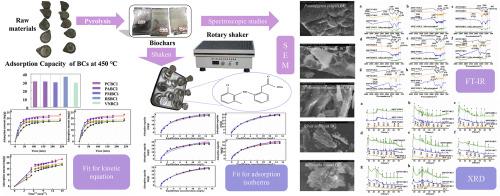Sustainable Chemistry and Pharmacy ( IF 5.5 ) Pub Date : 2020-06-12 , DOI: 10.1016/j.scp.2020.100275 Duo Xu , Zhaoxin Li , Peijing Wang , Wenrong Bai , Hao Wang

|
The ubiquitous prevalence of pharmaceuticals and personal care products (PPCPs) in water has aroused enormous public concerns. The development of promising materials for eliminating such contaminants in the water environment has attracted extensive attention in the scientific community. In this study, three (350 °C, 450 °C, and 600 °C, respectively) pyrolytic conditions were developed to prepare biochars (BCs), which were mainly prepared from the wastes of the overgrown plants (i.e., vallisneria natans, potamogeton malaianus, phragmites australis, potampgeton crispus, and river sediment additional). BCs were thoroughly characterised by various important properties (i.e., porosity and superficial functional group) and applied to remove diclofenac sodium (DS) drug from water media. Results indicated that the BCs adsorption capacity were remarkably improved when pyrolytic temperature was 450 °C and the adsorption equilibrium could be reached after 4 h (with BCs of 0.12 g/L and DS concentration of 12 mg/L). Batch adsorption experiments demonstrated a fit of Pseudo-second order (R2 = 0.992-0.996) and the Langmuir adsorption isotherm (R2 = 0.981-0.989) was suitable. The thermodynamic parameters derived from the fitting procedure point out the adsorption processes were all spontaneous and endothermic. The overall adsorption mechanism was regarded as pore filling, π-π interaction, van der Waals force, and π-electron attraction. This study stress out the main DS adsorption behavior using the above-mentioned materials was chemisorption predominated, but the adsorption capacity differs with different material properties. The prepared BCs can serve as potential carbonaceous porous adsorbents for removing DS from water media.
中文翻译:

在不同热解条件下产生的水生植物生物炭:双氯芬酸钠在水介质中的光谱研究和吸附行为
水中普遍存在的药品和个人护理产品(PPCP)引起了公众的极大关注。用于消除水环境中此类污染物的有前途的材料的开发已引起科学界的广泛关注。在这项研究中,3(350℃,450℃,600℃,分别地)的热解条件,开发了以制备生物炭(BCS),其主要是从长满植物的废料制备(即,苦草,眼子菜malaianus,澳洲芦苇,potampgeton crispus和河底沉积物。BC级彻底特点是各种重要特性(即,孔隙度和表面官能团),并用于从水介质中去除双氯芬酸钠(DS)药物。结果表明,当热解温度为450°C时,BCs的吸附能力得到了显着提高,并且在4 h后(BCs为0.12 g / L,DS浓度为12 mg / L)可以达到吸附平衡。分批吸附实验表明伪二级拟合(R 2 = 0.992-0.996)和Langmuir吸附等温线(R 2 = 0.981-0.989)是合适的。由拟合过程得出的热力学参数指出,吸附过程都是自发的并且是吸热的。总体吸附机理被认为是孔隙填充,π-π相互作用,范德华力和π电子吸引。这项研究强调了使用上述材料时主要的DS吸附行为是化学吸附为主的,但吸附能力随材料性质的不同而不同。制备的BCs可用作潜在的碳质多孔吸附剂,用于从水介质中去除DS。











































 京公网安备 11010802027423号
京公网安备 11010802027423号